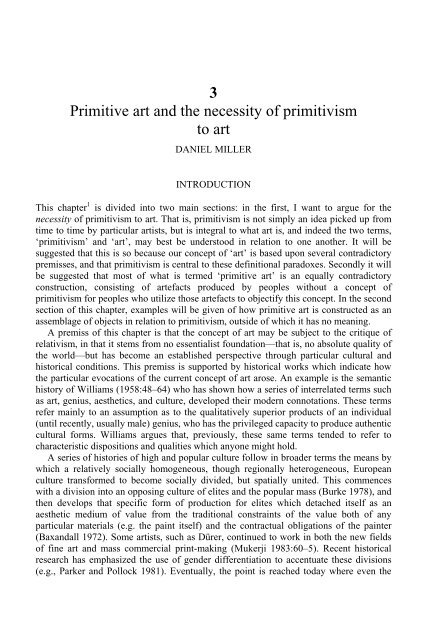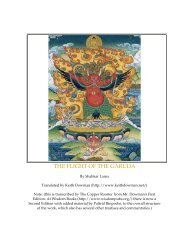Hiller - The Myth of Primitivism. Perspectives on Art - Esoteric Online
Hiller - The Myth of Primitivism. Perspectives on Art - Esoteric Online
Hiller - The Myth of Primitivism. Perspectives on Art - Esoteric Online
Create successful ePaper yourself
Turn your PDF publications into a flip-book with our unique Google optimized e-Paper software.
3<br />
Primitive art and the necessity <str<strong>on</strong>g>of</str<strong>on</strong>g> primitivism<br />
to art<br />
DANIEL MILLER<br />
INTRODUCTION<br />
This chapter 1 is divided into two main secti<strong>on</strong>s: in the first, I want to argue for the<br />
necessity <str<strong>on</strong>g>of</str<strong>on</strong>g> primitivism to art. That is, primitivism is not simply an idea picked up from<br />
time to time by particular artists, but is integral to what art is, and indeed the two terms,<br />
‘primitivism’ and ‘art’, may best be understood in relati<strong>on</strong> to <strong>on</strong>e another. It will be<br />
suggested that this is so because our c<strong>on</strong>cept <str<strong>on</strong>g>of</str<strong>on</strong>g> ‘art’ is based up<strong>on</strong> several c<strong>on</strong>tradictory<br />
premisses, and that primitivism is central to these definiti<strong>on</strong>al paradoxes. Sec<strong>on</strong>dly it will<br />
be suggested that most <str<strong>on</strong>g>of</str<strong>on</strong>g> what is termed ‘primitive art’ is an equally c<strong>on</strong>tradictory<br />
c<strong>on</strong>structi<strong>on</strong>, c<strong>on</strong>sisting <str<strong>on</strong>g>of</str<strong>on</strong>g> artefacts produced by peoples without a c<strong>on</strong>cept <str<strong>on</strong>g>of</str<strong>on</strong>g><br />
primitivism for peoples who utilize those artefacts to objectify this c<strong>on</strong>cept. In the sec<strong>on</strong>d<br />
secti<strong>on</strong> <str<strong>on</strong>g>of</str<strong>on</strong>g> this chapter, examples will be given <str<strong>on</strong>g>of</str<strong>on</strong>g> how primitive art is c<strong>on</strong>structed as an<br />
assemblage <str<strong>on</strong>g>of</str<strong>on</strong>g> objects in relati<strong>on</strong> to primitivism, outside <str<strong>on</strong>g>of</str<strong>on</strong>g> which it has no meaning.<br />
A premiss <str<strong>on</strong>g>of</str<strong>on</strong>g> this chapter is that the c<strong>on</strong>cept <str<strong>on</strong>g>of</str<strong>on</strong>g> art may be subject to the critique <str<strong>on</strong>g>of</str<strong>on</strong>g><br />
relativism, in that it stems from no essentialist foundati<strong>on</strong>—that is, no absolute quality <str<strong>on</strong>g>of</str<strong>on</strong>g><br />
the world—but has become an established perspective through particular cultural and<br />
historical c<strong>on</strong>diti<strong>on</strong>s. This premiss is supported by historical works which indicate how<br />
the particular evocati<strong>on</strong>s <str<strong>on</strong>g>of</str<strong>on</strong>g> the current c<strong>on</strong>cept <str<strong>on</strong>g>of</str<strong>on</strong>g> art arose. An example is the semantic<br />
history <str<strong>on</strong>g>of</str<strong>on</strong>g> Williams (1958:48–64) who has shown how a series <str<strong>on</strong>g>of</str<strong>on</strong>g> interrelated terms such<br />
as art, genius, aesthetics, and culture, developed their modern c<strong>on</strong>notati<strong>on</strong>s. <str<strong>on</strong>g>The</str<strong>on</strong>g>se terms<br />
refer mainly to an assumpti<strong>on</strong> as to the qualitatively superior products <str<strong>on</strong>g>of</str<strong>on</strong>g> an individual<br />
(until recently, usually male) genius, who has the privileged capacity to produce authentic<br />
cultural forms. Williams argues that, previously, these same terms tended to refer to<br />
characteristic dispositi<strong>on</strong>s and qualities which any<strong>on</strong>e might hold.<br />
A series <str<strong>on</strong>g>of</str<strong>on</strong>g> histories <str<strong>on</strong>g>of</str<strong>on</strong>g> high and popular culture follow in broader terms the means by<br />
which a relatively socially homogeneous, though regi<strong>on</strong>ally heterogeneous, European<br />
culture transformed to become socially divided, but spatially united. This commences<br />
with a divisi<strong>on</strong> into an opposing culture <str<strong>on</strong>g>of</str<strong>on</strong>g> elites and the popular mass (Burke 1978), and<br />
then develops that specific form <str<strong>on</strong>g>of</str<strong>on</strong>g> producti<strong>on</strong> for elites which detached itself as an<br />
aesthetic medium <str<strong>on</strong>g>of</str<strong>on</strong>g> value from the traditi<strong>on</strong>al c<strong>on</strong>straints <str<strong>on</strong>g>of</str<strong>on</strong>g> the value both <str<strong>on</strong>g>of</str<strong>on</strong>g> any<br />
particular materials (e.g. the paint itself) and the c<strong>on</strong>tractual obligati<strong>on</strong>s <str<strong>on</strong>g>of</str<strong>on</strong>g> the painter<br />
(Baxandall 1972). Some artists, such as Dürer, c<strong>on</strong>tinued to work in both the new fields<br />
<str<strong>on</strong>g>of</str<strong>on</strong>g> fine art and mass commercial print-making (Mukerji 1983:60–5). Recent historical<br />
research has emphasized the use <str<strong>on</strong>g>of</str<strong>on</strong>g> gender differentiati<strong>on</strong> to accentuate these divisi<strong>on</strong>s<br />
(e.g., Parker and Pollock 1981). Eventually, the point is reached today where even the




